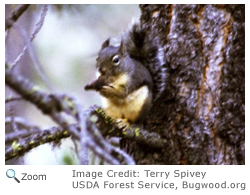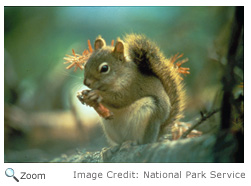Habitat
The Douglas squirrel lives in coniferous forests.
Diet
 The Douglas squirrel eats pine seeds. In the fall, it cuts green pine cones from tree limbs and buries them in special piles called middens. The Douglas squirrel also eat acorns, berries, mushrooms, and fruits.
The Douglas squirrel eats pine seeds. In the fall, it cuts green pine cones from tree limbs and buries them in special piles called middens. The Douglas squirrel also eat acorns, berries, mushrooms, and fruits.
Life Cycle
 Mating season for the Douglas squirrel is between late February and April. A little over a month after mating, the female gives birth to four to six babies. The babies are born with their eyes closed and are hairless. Their hair grows in a little over two weeks and their eyes open in about a month. They are weaned after eight weeks. The young squirrels may stay with their mother for most of their first year.
Mating season for the Douglas squirrel is between late February and April. A little over a month after mating, the female gives birth to four to six babies. The babies are born with their eyes closed and are hairless. Their hair grows in a little over two weeks and their eyes open in about a month. They are weaned after eight weeks. The young squirrels may stay with their mother for most of their first year.
Behavior
 The Douglas squirrel is very active during the day. It runs in the trees and on the ground. When the weather is bad, it stays in its nest. The Douglas squirrel builds a summer nest of moss, lichen, and pieces of bark and twigs. In the winter, it makes its nest in a hole in a tree. The Douglas squirrel is very territorial and very vocal.
The Douglas squirrel is very active during the day. It runs in the trees and on the ground. When the weather is bad, it stays in its nest. The Douglas squirrel builds a summer nest of moss, lichen, and pieces of bark and twigs. In the winter, it makes its nest in a hole in a tree. The Douglas squirrel is very territorial and very vocal.


 The Douglas squirrel is found from southwest British Columbia south to northern California.
The Douglas squirrel is found from southwest British Columbia south to northern California. 

